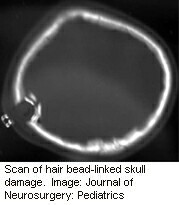 |
 |
 |

Hair Beads Spurring Head Trauma in Kids
And hard plastic versions often aren't visible on CT scans, experts note|
|
HealthDay
Wednesday, November 26, 2008
 WEDNESDAY, Nov. 26 (HealthDay News) -- Although head trauma is a common injury seen in young children, U.S. doctors report on two recent cases of skull fracture with a surprising cause -- hair beads.
WEDNESDAY, Nov. 26 (HealthDay News) -- Although head trauma is a common injury seen in young children, U.S. doctors report on two recent cases of skull fracture with a surprising cause -- hair beads.
What's worse, because the beads were translucent, they weren't readily apparent on diagnostic CT scans, the physicians say.
Study senior author Dr. Richard Anderson, a neurosurgeon at Columbia University College of Physicians and Surgeons in New York City, said these injuries aren't common by any means.
"These two cases occurred over the last two or three years. Hair beads are really only going to be a problem if [children] fall, like off a bunk bed, and fall on top of the bead," he said.
But, Anderson added, "since there are a million different types of hair accessories, why wear something that poses a risk?" Soft hair accessories might be a better choice, he advised.
Anderson and his colleagues reported their findings in the December issue of the Journal of Neurosurgery: Pediatrics.
The beads involved in these cases are the translucent type found on the ends of ponytail holders. Often, there is a bead at each end, and they're twisted together to hold the hair back. Each bead was more than 1 centimeter in diameter, or less than half an inch.
The first case involved a 4-year-old girl who fell from about four feet high and hit her head on the wooden leg of a bunk bed. The girl appeared fine, except for a head wound. She never lost consciousness and her neurological exam was fine. Emergency room doctors closed the wound with medical staples.
However, doctors could feel a defect in her skull, and a CT scan of her head showed a skull fracture with fragments. The doctors also saw what looked like a pocket of air trapped in the injured area. When neurosurgeons operated to remove the loose fragments, they discovered a hair bead embedded in the young girl's skull.
In the second case, a 2-and-a-half-year-old girl fell from the top bed of bunk beds. This time, the bead was still visible because it was protruding from the wound. The young girl's skull was fractured. She had surgery to remove the bead and repair her skull fracture.
Both youngsters had no surgical complications and recovered well from their injuries.
In both cases, Anderson said, the injury occurred because the child landed on the hair bead.
Overall, "hair beads are fairly benign," said Dr. Theodore Spinks, a pediatric neurosurgeon at Children's Hospital of Pittsburgh. "The larger perspective is that parents need to be careful of kids climbing. There are lots of things that can get impaled in kids' skulls if the fall is hard enough," he added.
The study authors agreed that myriad items can prove dangerous under the wrong circumstances. "Head injury due to impact from household items, including metal rods, wire, plugs, nails, kitchen utensils, writing instruments, hair accessories, lawn darts and equipment, scissors, bullets or pellets, golf balls and toys have been reported," they wrote.
And, they pointed out, young children, especially those under 2, are most at risk of sustaining a neurological injury because their skulls aren't yet fully formed.
Because so many objects can be involved in a penetrating head injury, Spinks said it would be impossible to remove every threat from your home. But, Anderson said that if something does happen, be sure to let the ER doctor know if your child was wearing a hair accessory.
HealthDay
Copyright (c) 2008 ScoutNews, LLC. All rights reserved.
Related News:
More News on this Date
Related MedlinePlus Pages:
| Home | Health Topics | Drugs & Supplements | Encyclopedia | Dictionary | News | Directories | Other Resources | |
| Disclaimers | Copyright | Privacy | Accessibility | Quality Guidelines U.S. National Library of Medicine, 8600 Rockville Pike, Bethesda, MD 20894 National Institutes of Health | Department of Health & Human Services |
Date last updated: 28 November 2008 |




